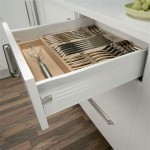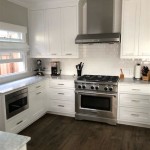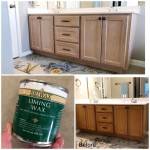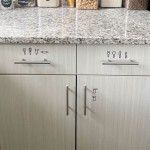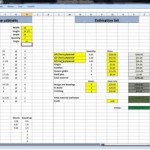How to Organise Your Kitchen Cupboards for Optimal Efficiency
Kitchen cupboards, often the unsung heroes of culinary spaces, are critical for functional food preparation and storage. Many kitchens, however, suffer from haphazardly organised cupboards, leading to frustration, wasted food, and inefficient workflow. Systematically organising kitchen cupboards is imperative not only for aesthetic appeal but also for maximizing space, reducing food waste, and streamlining the cooking process.
Before embarking on the organisation process, it is essential to understand the principles of efficient kitchen design. The core concept is to arrange items based on frequency of use and proximity to relevant workspaces. For example, cookware should be readily accessible near the stovetop and oven, while dishes and cutlery should be located close to the dishwasher or sink. This strategic arrangement minimises unnecessary movement and enhances overall kitchen efficiency.
The entire organisation strategy hinges on a methodical approach. The first step involves a complete decluttering process. Every item within the cupboards needs to be evaluated for its utility and relevance. This decluttering stage is crucial as it creates the necessary space to facilitate an effective organisation system. A thorough purge should eliminate expired items, duplicates, and any kitchen tools or appliances that are no longer used.
Decluttering and Inventory
The initial step in organising kitchen cupboards is a complete and thorough decluttering process. This involves removing everything from the cupboards and assessing each item. The assessment should focus on several key questions: Is the item still needed? Is it in good working condition? Does it serve a purpose in the kitchen? Has it been used in the last year? Items that fail to meet these criteria should be discarded, donated, or repurposed.
Begin by removing all items from each cupboard. Completely empty each space before moving onto the next. This allows for a comprehensive evaluation of the total inventory and the available storage space. As items are removed, group them into categories: cookware, dishes, pantry staples, small appliances, and so on. This categorisation provides a clearer overview of the types of items that need to be stored.
Carefully inspect each item for damage, expiration dates, or signs of wear and tear. Expired food should be discarded immediately. Damaged or broken items, such as chipped dishes or non-functional appliances, should also be removed. Items that are still in good condition but are no longer needed can be donated to local charities or sold online.
During the decluttering process, identify duplicate items. Many kitchens contain multiple versions of the same tool or appliance. Retain only the best quality or most frequently used version and eliminate the rest. This reduces clutter and frees up valuable storage space.
Once the decluttering process is complete, take inventory of the remaining items. This inventory will guide the organisation process and help determine the best storage solutions. Categorise the items based on frequency of use: daily, weekly, or occasional. This categorisation will inform the placement of items within the cupboards.
Consider taking photographs of the inside of the cupboards before and after decluttering. This visual aid can be helpful in maintaining organisation and preventing future clutter accumulation. It can also serve as a reminder of the progress made and the importance of maintaining an organised kitchen.
Implementing Effective Storage Solutions
Once the decluttering stage is completed and the remaining items have been inventoried, the next step is to implement effective storage solutions. This involves selecting and utilising storage containers, shelf organisers, and other tools to maximize space and improve accessibility within the cupboards. Choosing the right storage solutions can transform cluttered cupboards into functional and efficient storage spaces.
Selecting appropriate storage containers is crucial for maintaining an organised pantry. Opt for clear, airtight containers to store dry goods such as flour, sugar, rice, pasta, and cereals. Clear containers allow for easy identification of contents, while airtight seals help to preserve freshness and prevent pests. Consider using stackable containers to maximise vertical space within the cupboards.
Shelf organisers can significantly increase storage capacity within kitchen cupboards. Adjustable shelves can be used to create custom storage solutions, allowing for optimal utilisation of vertical space. Under-shelf baskets can be used to store smaller items such as spices, tea bags, or cleaning supplies. Wire racks can be used to store plates, pots, and pans, making them easily accessible.
Drawer dividers are essential for organising cutlery, utensils, and other small kitchen tools. Dividers help to keep items separated and prevent clutter. Adjustable dividers allow for customisation of drawer space to accommodate various sizes and shapes of items.
Lazy Susans are particularly useful for organising corner cupboards or pantries. These rotating trays allow for easy access to items stored at the back of the cupboard. Lazy Susans can be used to store spices, condiments, or canned goods.
Door-mounted racks provide additional storage space for items such as spice jars, cleaning supplies, or baking sheets. These racks utilise the often-overlooked space on the inside of cupboard doors. Ensure that the racks are securely mounted and that the items stored do not obstruct the closing of the doors.
Maximising vertical space is a key principle of effective cupboard organisation. Utilise the full height of the cupboards by adding additional shelves or using stacking containers. This increases storage capacity and prevents items from being stacked haphazardly on top of each other.
Strategic Placement and Maintenance
The final, and arguably most important, aspect of organising kitchen cupboards is the strategic placement of items and the establishment of a maintenance routine. This involves arranging items based on frequency of use and proximity to related work areas, as well as implementing strategies to maintain the organised state over time. Without a well-defined placement strategy and a consistent maintenance plan, even the most meticulously organised cupboards can quickly revert to chaos.
Items that are used most frequently should be placed in easily accessible locations, such as the front of the shelves or at eye level. Less frequently used items can be stored higher up or at the back of the cupboards. This arrangement ensures that essential items are readily available, while less commonly used items are stored out of the way.
Arrange items based on their relationship to specific tasks or appliances. For example, cookware should be stored near the stovetop or oven, while dishes and cutlery should be stored near the dishwasher or sink. This proximity reduces unnecessary movement and improves workflow in the kitchen.
Labeling storage containers is essential for maintaining organisation and preventing confusion. Clearly label each container with its contents, using a permanent marker or label maker. This ensures that items are easily identifiable and prevents accidental misplacement.
Establish a routine for periodic cupboard maintenance. This involves regularly decluttering, reorganising, and restocking items. A quick weekly or monthly review can prevent clutter from accumulating and ensure that the cupboards remain organised.
Implement a "one in, one out" rule to prevent overstocking. For every new item that is added to the cupboard, an existing item should be removed, either by being used, donated, or discarded. This helps to maintain a manageable inventory and prevents clutter from accumulating.
Enlist the help of other household members to maintain the organised state of the kitchen cupboards. Clearly communicate the organisation system and encourage everyone to follow the established guidelines. This collaborative approach ensures that the organisation efforts are sustained over time.
Consider implementing a system for rotating food items. When restocking pantry staples, place the newest items at the back of the shelf and move the older items to the front. This ensures that older items are used first, reducing the risk of spoilage and waste.
Regularly check expiration dates of food items and discard any expired products. This prevents the accumulation of expired food and ensures that the cupboards remain clean and hygienic.
By implementing these strategies, it is possible to create and maintain organised kitchen cupboards that enhance efficiency, reduce food waste, and contribute to a more enjoyable cooking experience. The initial investment in decluttering, organising, and establishing a maintenance routine will yield long-term benefits in terms of time saved, reduced frustration, and a more functional kitchen space.

40 Best Ideas For How To Organize Kitchen Cabinets

This Is How To Organise Your Kitchen Cupboards Plastic Box

60 Clever Cabinet Organization Tips To Double Your Storage 2024

How To Organize Kitchen Cabinets Clean And Scentsible

How To Organize Your Kitchen Cabinets Step By Project The Container

40 Best Ideas For How To Organize Kitchen Cabinets

How To Organize Your Kitchen Cabinets And Pantry Feed Me Phoebe

This Is How To Organise Your Kitchen Cupboards Plastic Box

Organizing A Lunch Station Organize Your Kitchen Frugally Day 5 Homelife

How To Organize Your Kitchen Cabinets And Pantry Feed Me Phoebe
Related Posts

